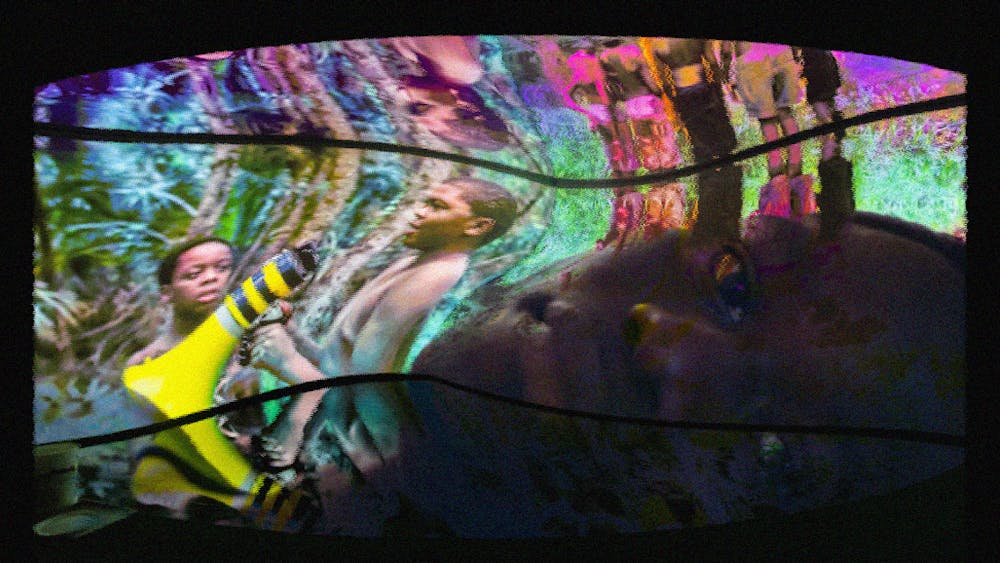Entering a dark room with a beige couch and small coffee table, I faced a large television with blue dots and specks of yellow moving across the top of the screen over a chorus of buzzes. I feel as though I’m standing in a living room, with a portrait of an older woman in one corner. On my left, the name and description of the exhibition: Terence Nance: Swarm. As I move through the exhibition, I see a variety of films highlighting a recurring theme of Black identity and I am surrounded by the production of art through sound and video.
Curated by Maori Karmael Holmes, Swarm was one of the exhibitions featured at the Institute of Contemporary Art during their After Dark event, where students at Penn and other colleges in Philadelphia could explore the connections between art and culture, with access to exhibitions like Swarm and Long Take. The event also included refreshments such as mango–lemon mocktail margaritas, tote bag screen printing, and glow–in–the–dark face painting.
Terrance Nance is a filmmaker, director, and musician known for his 2012 film An Oversimplification of Her Beauty, and the HBO television series, Random Acts of Flyness. His exhibition, Swarm, created in partnership between BlackStar Projects and the Institute of Contemporary Art, combines film and sound to feature five captivating presentations.
After I walk past the first presentation, I wonder what connections Nance could be about to draw between his former cinematic pieces. I suddenly come across a display of black chains forming the words “BLAACK MATTER.” As I venture behind a curtain, I notice two projected screens side by side showcasing a variety of clips. A man dancing in a yellow outfit, which quickly fades to a child holding a microphone. The scene eventually switches to a woman in a forest hand painting on the backs of children using yellow paint. In these clips, Nance delves deeper into his identity and his communities. By combining visual and auditory imagery, he demonstrates his role within the communities he belongs to, which are symbolized through the swarms of bees that are hinted within his pieces.
In a Vogue interview, Holmes, Chief Executive & Artistic Officer of BlackStar Projects, described her intentions behind the immersive environment. “I want people to feel inspired by the show [to consider] what they might do with their own work. To be able to be freed, in some ways, [and see that] at the end of the day your work can actually do other things,” she says.
The name of Nance’s exhibition, Swarm, honors the community of people who stood by and supported him, including his friends and family. His pieces reflect the influence of his family, including his brother, Nelson Mandela Nance, and his mother, Vickie Washington. Holmes explains, “He has been able to make work both in Hollywood and outside of it and always maintaining a vision of himself and bringing his community—or the Swarm—along with him.”
Another one of Nance's pieces at the exhibition brings together various clips while outlining the story of a white producer aiming to create a movie in the Congo. The presentation begins with a man at a beach on the screen, and the words “white angel” above it. Captivated by missionaries that “save” children by adopting them from the Congo, the producer wants to write and produce a movie featuring one particular missionary.
Following the story of this producer, Nance touches upon the white savior complex and how many white Americans, such as these missionaries, feel the necessity to “rescue” those from the global south. The clips demonstrate the dangers of this complex when the consequences of colonialism and other historical struggles are left ignored. In between this story, Nance provides other clips that highlight different aspects of his identity and shed light on social justice issues. One prominent clip features statistics from the CDC that address Black maternal mortality. The clip explains the discrimination experienced by Black pregnant women, leading to a mortality rate of three to four times higher compared to white women.
With this exhibition, Nance and Holmes create five interdisciplinary and immersive pieces through the artistic applications of film and sound. In Swarm, Nance delves deep into his identity, challenges societal issues, and inspires other artists to leave a long–lasting impact through their art. Through these layered presentations, Nance weaves together different stories and relationships and hopes to inspire other filmmakers and extend the legacy of the Black Arts Movement. This piece leads both students and art enthusiasts alike to wanting to see what’s next in Terrance Nance’s artistic journey.







